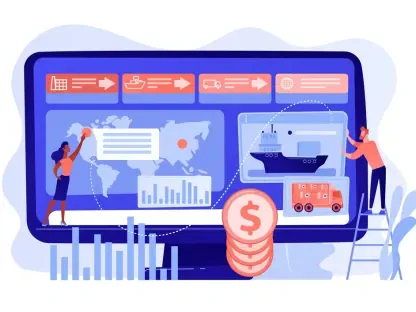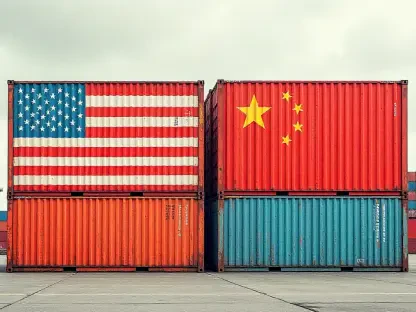In an era where global trade binds economies tighter than ever, the fragility of supply chains has been exposed by relentless geopolitical storms and economic turbulence, leaving industries scrambling to adapt to unprecedented delays and cost surges that challenge the very foundation of modern commerce. This vulnerability has become a defining challenge of the marketplace, as businesses grapple with the ripple effects of trade wars, tariff battles, and market imbalances that show no signs of abating. Understanding these disruptions is paramount for stakeholders aiming to navigate an interconnected world where a single policy shift can halt production lines across continents. This analysis delves into the current state of global supply chain challenges, explores real-world impacts, incorporates expert insights, and peers into the future to uncover both risks and opportunities, concluding with actionable takeaways for a path forward.
Current Landscape of Global Supply Chain Challenges
Scale and Drivers of Disruptions
The magnitude of global supply chain disruptions is staggering, with recent data painting a grim picture of an industry under strain. Reports from market analytics platforms indicate that shipping delays have surged by over 30% on key routes, while container costs have skyrocketed, sometimes doubling within months due to capacity constraints. These imbalances are compounded by a persistent mismatch between supply and demand, with overcapacity looming as a critical issue projected to intensify through the next two years.
Geopolitical tensions, particularly between major economies like the US and China, remain a primary catalyst for these challenges. Trade wars have led to tariffs that disrupt cost structures, forcing operational overhauls across the shipping sector. Additionally, economic slowdowns are dampening demand, with indicators such as the Purchasing Managers’ Index (PMI) reflecting a consistent decline in manufacturing activity, a trend expected to persist and further strain supply chains into the near future.
Beyond policy and economic factors, logistical bottlenecks exacerbate the crisis. Port congestion and labor shortages have slowed turnover rates, while the influx of new vessels—despite softening demand—creates a surplus that carriers struggle to manage. This convergence of forces illustrates a complex web of disruption that defies quick resolution, setting the stage for prolonged uncertainty.
Real-World Manifestations and Case Studies
Across industries, the tangible effects of supply chain disruptions are reshaping business operations in profound ways. Container shipping delays have become commonplace, with some companies reporting wait times extending weeks beyond normal schedules, directly impacting production timelines for manufacturers reliant on just-in-time inventory models. Retailers, in particular, face stock shortages during peak seasons, eroding consumer confidence and profit margins.
Specific examples highlight the adaptive measures being taken to mitigate these issues. Many importers have resorted to stockpiling inventory, front-loading shipments to hedge against potential tariff hikes or further delays, a strategy that temporarily alleviates shortages but inflates warehousing costs. Meanwhile, shipping carriers are employing tactics such as slow steaming—reducing vessel speeds to save fuel—and blank sailings, where scheduled trips are canceled to manage overcapacity, though these often frustrate shippers needing reliable service.
A notable case involves multinational corporations adjusting sourcing strategies to circumvent disrupted trade lanes. Some have shifted suppliers to alternative regions, a costly but necessary pivot to avoid the fallout from geopolitical flashpoints. These real-world responses underscore the pervasive nature of supply chain challenges, revealing both the ingenuity and the strain felt by businesses striving to maintain continuity in turbulent times.
Expert Perspectives on Supply Chain Dynamics
Industry leaders offer sobering insights into the entrenched nature of current disruptions, emphasizing that temporary policy relief falls short of reversing the damage. Peter Sand, a chief analyst at a leading market analytics firm, notes that carriers have already restructured operations to absorb the financial blow of tariffs, embedding inefficiencies that cannot be undone overnight. This perspective highlights a critical reality: the supply chain landscape has been fundamentally altered by recent upheavals.
Further complicating the outlook is the uncertainty tied to pending legal and policy developments. Experts point to unresolved issues, such as potential rulings on tariff legitimacy in the US, which could redefine trade frameworks in the coming months. Ted Chen, an authority from a prominent freight forwarding company, describes the industry as being in “observer mode,” with shippers hesitant to commit to long-term plans amid fears of sudden cost escalations. Such caution is deemed prudent, given the fleeting nature of trade truces that offer only short-term respite.
Looking ahead, there is consensus among analysts that the market will tilt in favor of shippers by the end of the next two years, driven by persistent overcapacity. This shift is expected to prioritize reliability and flexible contract terms as key negotiation levers, with carriers compelled to offer more than just competitive rates. Experts advocate for strategic patience, urging stakeholders to build adaptability into their agreements to weather ongoing volatility while capitalizing on emerging opportunities.
Future Outlook: Navigating Uncertainty and Opportunity
As supply chains evolve, the period through the next two years promises both heightened competition and potential relief for certain players. An influx of new vessel deliveries is set to exacerbate overcapacity, pushing carriers into a fierce battle for market share. This surplus could drive down shipping rates, offering shippers a window to secure favorable terms, though it poses a significant profitability challenge for carriers already squeezed by economic headwinds.
The benefits for shippers extend beyond cost reductions, with the potential for broader network coverage and enhanced service reliability as carriers vie for business. However, this advantage is tempered by broader risks, including geopolitical volatility that could reignite trade disputes at a moment’s notice. Persistent economic softness, evidenced by declining global manufacturing activity, may further suppress demand, creating a precarious balance between opportunity and instability in the trade ecosystem.
On a macro level, these dynamics are likely to reshape global trade patterns in unforeseen ways. Continued disruptions could accelerate trends toward regionalization, as companies seek closer supply sources to minimize exposure to international friction. Yet, this also opens avenues for resilience, with businesses that invest in diversified sourcing and agile logistics poised to thrive amid uncertainty. The coming years will test the industry’s capacity to adapt, balancing immediate pressures with long-term strategic gains.
Key Takeaways and Path Forward
The analysis reveals that supply chain disruptions are deeply rooted, with damage from geopolitical and economic forces proving resistant to quick fixes. Overcapacity stands as a looming concern, poised to redefine market dynamics by the end of the next two years, while creating a shipper-friendly environment that demands careful navigation. These insights underscore a pivotal moment for the industry, where strategic foresight becomes a cornerstone of survival.
Reflecting on the journey through this complex landscape, it becomes clear that staying informed and adaptable is not just beneficial but essential in such a volatile trade environment. Businesses are encouraged to seize current trends as leverage in negotiations, pushing for contracts that prioritize flexibility to mitigate sudden shifts in costs or demand. Looking back, the emphasis on resilience shapes a crucial lesson: stakeholders who have invested in diversified supply networks and dynamic planning emerge stronger, setting a precedent for others to follow in fortifying their operations against future uncertainties.









